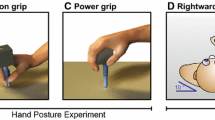Abstract
Studies examining dual adaptation to opposing novel environments have yielded contradictory results, with previous evidence supporting both successful dual adaptation and interference leading to poorer adaptive performance. Whether or not interference is observed during dual adaptation appears to be dependent on the method used to allow the performer of the task to distinguish between two novel environments. This experiment tested if colour cues, a separation in workspace, and presentation schedule, could be used to distinguish between two opposing visuomotor rotations and enable dual adaptation. Through the use of a purpose designed manipulandum, each visuomotor rotation was either presented in the same region of workspace and associated with colour cues (Group 1), different regions of workspace in addition to colour cues (Groups 2 and 3) or different regions of workspace only (Groups 4 and 5). We also assessed the effectiveness of the workspace separation with both randomised and alternating presentation schedules (Groups 4 and 5). The results indicated that colour cues were not effective at enabling dual adaptation when each of the visuomotor rotations was associated with the same region of workspace. When associated with different regions of workspace, however, dual adaptation to the opposing rotations was successful regardless of whether colour cues were present or the type of presentation schedule.




Similar content being viewed by others
References
Bays P, Flanagan R, Wolpert DM (2005) Interference between velocity-dependent and position-dependent force-fields indicates that tasks depending on different kinematic parameters compete for motor working memory. Exp Brain Res 163:400–405
Bock O, Worringham C, Thomas M (2005) Concurrent adaptations of left and right arms to opposite visual distortions. Exp Brain Res 162:513–519
Brashers-Krug T, Shadmehr R, Bizzi E (1996) Consolidation in human motor memory. Nature 382:252–255
Cunningham HA (1989) Aiming error under transformed spatial map**s suggests a structure for visual-motor maps. J Exp Psychol Hum Percept Perform 15:493–506
Gandolfo F, Mussa-Ivaldi F, Bizzi E (1996) Motor leaning by field approximation. Proc Natl Acad Sci USA 93:3843–3846
Ghahramani Z, Wolpert D (1997) Modular decomposition in visuomotor learning. Nature 386:392–395
Hwang EJ, Donchin O, Smith M, Shadmehr R (2003) A gain-field encoding of limb position and velocity in the internal model of arm dynamics. PLoS Biol 1:209–220
Karniel A, Mussa-Ivaldi F (2002) Does the motor control system use multiple models and context switching to cope with a variable environment? Exp Brain Res 143:520–524
Krakauer JW, Ghilardi MF, Ghez C (1999) Independent learning of internal models for kinematic and dynamic control of reaching. Nat Neurosci 2:1026–1031
Krakauer JW, Pine ZM, Ghilardi MF, Ghez C (2000) Learning of visuomotor rotations for vectorial planning of reaching trajectories. J Neurosci 20:8916–8924
Osu R, Hirai S, Yoshioka T, Kawato M (2004) Random presentation enables subjects to adapt to two opposing forces on the hand. Nat Neurosci 7:111–112
Shadmehr R, Mussa-Ivaldi F (1994) Adaptive representation of dynamics during learning of a motor task. J Neurosci 14:3208–3224
Shemmell J, Forner M, Tresilian JR, Riek S, Barry BK, Carson RG (2005) Neuromuscular adaptation during skill acquisition on a two degree-of-freedom target acquisition task: isometric torque production. J Neurophysiol 94:3046–3057
Teasdale N, Bard C, Fleury M, Young DE, Proteau L (1993) Determining movement onsets from temporal series. J Mot Behav 25:97–106
Wada Y, Kawabata Y, Kotosaka S, Yamamoto K, Kitazawa S, Kawato M (2003) Acquisition and contextual switching of multiple internal models for different viscous force-fields. Neurosci Res 46:319–331
Wang J, Sainburg RL (2005) Adaptation to visuomotor rotations remaps movement vectors, not final positions. J Neurosci 25:4024–4030
Wigmore V, Tong C, Flanagan JR (2002) Visuomotor rotations of varying size and direction compete for a single model in motor working memory. J Exp Psychol Hum Percept Perform 28:447–457
Author information
Authors and Affiliations
Corresponding author
Rights and permissions
About this article
Cite this article
Woolley, D.G., Tresilian, J.R., Carson, R.G. et al. Dual adaptation to two opposing visuomotor rotations when each is associated with different regions of workspace. Exp Brain Res 179, 155–165 (2007). https://doi.org/10.1007/s00221-006-0778-y
Received:
Accepted:
Published:
Issue Date:
DOI: https://doi.org/10.1007/s00221-006-0778-y




